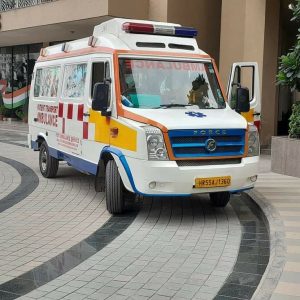What is MDT in Ambulance?
MDT stands for Mobile Data Terminal. It’s a rugged computer system mounted in ambulances that serves as a vital communication and information hub for paramedics and emergency medical technicians (EMTs).
Think of it as a command center within the ambulance, providing:
- Real-time communication: The MDT allows crews to receive dispatch information, and updates from the hospital, and communicate with other emergency responders, all without relying solely on voice radios.
- Patient information: The MDT displays crucial details about the patient, such as medical history, allergies, and medications, enabling informed treatment decisions.
- Navigation: Integrated GPS and mapping software guide paramedics to the scene efficiently, even in unfamiliar areas.
- Reporting: After patient care, the MDT facilitates electronic reporting, streamlining documentation and improving data collection.
Overall, the MDT plays a critical role in improving response times, enhancing patient care, and ensuring the safety of medical crews.
Introduction to MDT in Ambulance
The concept of MDT in ambulances revolves around the idea of assembling a diverse team of experts who collectively contribute their specialized knowledge and skills to manage complex medical emergencies effectively. This approach goes beyond the traditional model of emergency response, which typically involves paramedics working in isolation. Also, read about Internet Essentials Phone Number
Understanding MDT (Multi-Disciplinary Team)
MDT in ambulance services involves a coordinated effort among medical personnel, paramedics, specialists, social workers, and technological support staff. Each member of the team plays a unique role in assessing, treating, and stabilizing patients during transit to healthcare facilities.
Importance of MDT in Ambulance Services
The significance of MDT in ambulance services lies in its ability to provide holistic care to patients in critical conditions. By integrating expertise from various disciplines, MDT ensures comprehensive assessment, timely intervention, and seamless coordination throughout the continuum of care. For more interesting information visit our website bytetechsolution.com
Components of MDT in Ambulance
Medical Personnel
Medical personnel, including doctors and nurses, bring clinical expertise and decision-making capabilities to the MDT. Their ability to assess patients’ conditions and administer appropriate treatments is invaluable in pre-hospital care settings.
Paramedics
Paramedics form the backbone of ambulance services, providing frontline medical care and transportation for patients. Their training in emergency medical procedures and protocols is essential for ensuring prompt and effective interventions.
Specialists
Specialists, such as trauma surgeons, cardiologists, and neurologists, may be called upon to provide specialized medical interventions during transit. Their expertise is crucial for managing complex medical emergencies and improving patient outcomes.
Social Workers
Social workers play a vital role in addressing the psychosocial needs of patients and their families during emergencies. They provide support, guidance, and advocacy to ensure patients receive the holistic care they require.
Technological Support
Technological support staff manage the equipment and systems used in ambulances, such as monitoring devices, communication tools, and electronic health records. Their role is essential for ensuring the seamless operation of medical equipment and data management systems.

Collaboration and Communication in MDT
Effective collaboration and communication are the cornerstones of MDT in ambulance services. Clear communication channels, standardized protocols, and regular team meetings facilitate coordination and decision-making, leading to improved patient outcomes.
Benefits of Implementing MDT in Ambulance Services
The implementation of MDT in ambulance services offers several benefits, including:
- Enhanced clinical outcomes
- Improved efficiency and resource utilization
- Reduced response times and transport delays
- Better coordination with healthcare facilities
- Enhanced patient and provider satisfaction
Challenges Faced by MDT in Ambulance Services
Despite its numerous advantages, MDT in ambulance services also faces several challenges, including:
- Logistical constraints: Limited resources and infrastructure may hinder the implementation of MDT.
- Interdisciplinary conflicts: Differences in professional perspectives and priorities can lead to conflicts within the MDT.
- Communication barriers: Inadequate communication channels and language barriers may impede effective collaboration among team members.
Case Studies: Successful Implementation of MDT in Ambulance Services
Several ambulance services worldwide have successfully implemented MDT, resulting in significant improvements in patient care and outcomes. For example, the London Ambulance Service’s implementation of MDT protocols has led to reduced mortality rates and enhanced pre-hospital care delivery.

Future Prospects and Innovations in MDT for Ambulance Services
As technology advances and healthcare systems evolve, the future of MDT in ambulance services holds promising innovations. From the integration of artificial intelligence and telemedicine to the development of specialized training programs for MDT members, ongoing advancements aim to further optimize emergency medical care delivery.
Conclusion
MDT represents a paradigm shift in ambulance services, emphasizing collaboration, communication, and comprehensive care delivery. By harnessing the collective expertise of diverse professionals, MDT ensures that patients in critical conditions receive the timely and appropriate interventions they need to improve outcomes.
FAQs
What role do paramedics play in MDT in ambulance services?
Paramedics provide frontline medical care and transportation for patients, working collaboratively with other MDT members to assess, treat, and stabilize patients during transit.
How does MDT benefit patients in critical conditions?
MDT ensures comprehensive assessment, timely intervention, and seamless coordination throughout the continuum of care, leading to improved clinical outcomes and patient satisfaction.
What are the main challenges faced by MDT in ambulance services?
Logistical constraints, interdisciplinary conflicts, and communication barriers are among the main challenges faced by MDT in ambulance services, which may hinder effective collaboration and care delivery.
Are there any successful examples of MDT implementation in ambulance services?
Yes, ambulance services like the London Ambulance Service have successfully implemented MDT protocols, resulting in reduced mortality rates and enhanced pre-hospital care delivery.
What does the future hold for MDT in ambulance services?
The future of MDT in ambulance services holds promising innovations, including the integration of technology, telemedicine, and specialized training programs aimed at further optimizing emergency medical care delivery.
